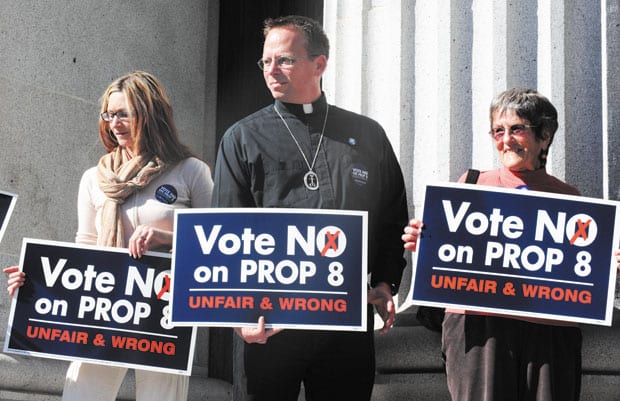
1972: Minnesota U.S. Supreme Court dismisses Baker v Nelson, the first court case in which same-sex couples sued for the right to legally marry.
1973: Maryland becomes the first state to pass a statute banning same-sex marriages.
1975: Colorado. In Boulder, a county clerk issues marriage licenses to six same-sex marriages couples, and one couple files the first federal lawsuit for same-sex marriages. The trial court ruling in favor was struck by the 9th Circuit Court of Appeals in 1982.
1993: The Hawaii Supreme Court rules in Baehr v Miike that denying same-sex couples the right to marry violates the Equal Protection Clause of the Hawaii Constitution.
1996: Washington D.C. President Bill Clinton signs the Defense of Marriage Act (DOMA), saying that states do not have to recognize same-sex marriages from other jurisdictions, and that the federal government will not recognize same-sex marriages.
1998: Hawaii becomes the first state to amend its constitution to ban legal recognition of same-sex marriage.
1999: California becomes the first state to create a domestic partnership statute, allowing same-sex couple access to some of the legal benefits of marriage.
2000: Vermont’s Supreme Court rules in Baker v State of Vermont that same-sex couples must be treated equally and the state establishes civil unions while continuing to deny same-sex couples access to marriage.
2003: Texas. In a ruling issued on June 26, in the case Lawrence v Texas, the U.S. Supreme Court strikes down sodomy laws nationwide. This ruling, declaring unconstitutional state laws that have criminalized consensual sexual contact between adults of the same gender, paved the way for LGBT civil rights victories in the years ahead.
2004: Massachusetts becomes the first state in the U.S. to grant legal recognition to same-sex marriages, due to a ruling by the state’s Supreme Judicial Court.
2005: The California Legislature became the first state legislature to vote to give legal recognition to same-sex marriage. The bill, however, is vetoed by then-Gov. Arnold Schwarzenegger.
2005: Texas voters approve Proposition 2, a constitutional amendment banning legal recognition of same-sex marriage, by a 3-to-1 margin.
2008: The California Supreme Court rules that excluding same-sex couples from the legal benefits of marriage is unconstitutional. Within months, voters in the state approve Proposition 8, a constitutional amendment banning same-sex marriage.
2009: The California Supreme Court upholds Proposition 8.
2010: Massachusetts. A U.S. district court rules that DOMA’s Section 3, prohibiting the federal government from recognizing same-sex marriages performed in jurisdictions where they are legal, violates the U.S. Constitution.
2010: The U.S. District Court of Northern California declares that Prop 8 violates U.S. Constitution. The case is later appealed to the U.S. 9th Circuit Court of Appeals.
2011: President Barack Obama’s Department of Justice stops defending DOMA.
2012: California. The U.S. Ninth Circuit Of Appeals upholds the trial ruling declaring Prop 8 to be unconstitutional.
2012: Massachusetts. A U.S. district court rules that DOMA is unconstitutional.
2012: Washington, D.C. President Barack Obama becomes the first U.S. president to pledge full support for legal recognition of same-sex marriage.
2012: U.S. 9th Circuit Court of Appeals upholds a trial court ruling declaring Prop 8 unconstitutional. California state officials decline to appeal the ruling to the U.S. Supreme Court, and when right-wing anti-gay advocates try to take the case to the Supreme Court, the justices decline to hear the appeal, saying the anti-gay advocates have no standing to appeal.
2012: The Democratic Party becomes the first major political party to endorse legal recognition of same-sex marriage in its party platform.
2013: Washington, D.C. The U.S. Supreme Court, on June 26, issues a ruling in U. S. v Windsor striking down that portion of DOMA prohibiting the federal government from recognizing legal same-sex marriages.
2014: In February a federal district judge in San Antonio rules that Texas’ constitutional amendment banning recognition of same-sex marriages violates the U.S. Constitution.
2014: Washington, D.C. In October, the U.S. Supreme Court declines to hear appeals of several lower court rulings that struck down same-sex marriage bans, causing the number of marriage equality states to jump from 19 to 30 within a month.
2015: Washington, D.C. The U.S. Supreme Court, on June 26, issues its ruling in Obergefell v Hodges, declaring that state bans on legal recognition of same-sex marriage are unconstitutional, making marriage equality the law of the land.
This article appeared in the Dallas Voice print edition July 3, 2015.



